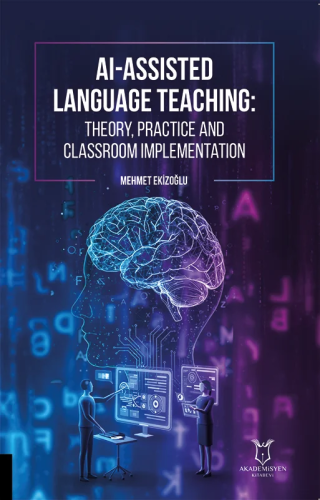AI-Assisted Language Teaching Theory, Practice, and Classroom Implementation

TANITIM YAZISI
CHAPTER 1
FOUNDATIONS OF AI IN ENGLISH LANGUAGE TEACHING (ELT)
1.1 What is Artificial Intelligence?
1.1.1 Definitions and Key Concepts
1.1.2 Types of AI
1.2 AI Technologies in Language Learning
1.2.1 Natural Language Processing (NLP)
1.2.2 Machine Learning and Adaptive Learning Systems
1.2.3 Speech Recognition and Speech Synthesis
1.2.4 Chatbots and Virtual Assistants in Language Learning
1.3 Theoretical Foundations of AI in Language Learning
1.3.1 SLA Theories and AI
1.3.2 AI and Personalized Learning Pathways
CHAPTER 2
PRACTICAL APPLICATIONS OF AI IN ENGLISH
LANGUAGE CLASSROOMS
2.1 Personalized Learning Environments
2.2 Automated Assessment and Feedback
2.3 AI-Powered Language Practice Tools
2.4.1 Overview of AI Tools for Teachers and Their Classroom Uses
2.5 Classroom Management and Administration
2.4 AI in Content Creation and Lesson Plannin
CHAPTER 3
CASE STUDIES AND REAL-WORLD EXAMPLES
3.1 Successful Implementations
3.1.1 Case Study 1: AI in a High School English Class
3.1.2 Case Study 2: AI in a University ESL Program
3.2 Lessons Learned
3.2.1 Best Practices for AI Implementation
3.2.2 Common Pitfalls and Challenges
3.2.3 Ethical Considerations in AI-Powered Language Learning
3.3 Teacher and Student Perspectives
3.3.1 Educator Perspectives
3.3.2 Student Perspectives
3.3.3 Balancing AI and Traditional Teaching
CHAPTER 4
CHALLENGES AND ETHICAL CONSIDERATIONS IN AIASSISTED
LANGUAGE LEARNING
4.1 Technical Challenges in AI Integration
4.1.1 System Compatibility and Infrastructure Issues
4.1.2 Reliability and Accuracy of AI Tools
4.2 Ethical Considerations in AI-Driven Language Learning
4.2.1 Data Privacy and Security
4.2.2 Bias and Fairness in AI Algorithms
4.3 Access and Equity in AI-Assisted Language Learning
4.3.1 The Digital Divide
4.3.2 Inclusive AI for Students with Disabilities
4.4 Teacher Readiness and AI Training
4.4.1 Professional Development for Educators
4.4.2 Overcoming Resistance to AI Adoption
4.5 Future Directions and Policy Considerations
4.5.1 Ethical AI Development
4.5.2 The Role of Policymakers and Institutions
REFERENCES
- Açıklama
TANITIM YAZISI
CHAPTER 1
FOUNDATIONS OF AI IN ENGLISH LANGUAGE TEACHING (ELT)
1.1 What is Artificial Intelligence?
1.1.1 Definitions and Key Concepts
1.1.2 Types of AI
1.2 AI Technologies in Language Learning
1.2.1 Natural Language Processing (NLP)
1.2.2 Machine Learning and Adaptive Learning Systems
1.2.3 Speech Recognition and Speech Synthesis
1.2.4 Chatbots and Virtual Assistants in Language Learning
1.3 Theoretical Foundations of AI in Language Learning
1.3.1 SLA Theories and AI
1.3.2 AI and Personalized Learning Pathways
CHAPTER 2
PRACTICAL APPLICATIONS OF AI IN ENGLISH
LANGUAGE CLASSROOMS
2.1 Personalized Learning Environments
2.2 Automated Assessment and Feedback
2.3 AI-Powered Language Practice Tools
2.4.1 Overview of AI Tools for Teachers and Their Classroom Uses
2.5 Classroom Management and Administration
2.4 AI in Content Creation and Lesson Plannin
CHAPTER 3
CASE STUDIES AND REAL-WORLD EXAMPLES
3.1 Successful Implementations
3.1.1 Case Study 1: AI in a High School English Class
3.1.2 Case Study 2: AI in a University ESL Program
3.2 Lessons Learned
3.2.1 Best Practices for AI Implementation
3.2.2 Common Pitfalls and Challenges
3.2.3 Ethical Considerations in AI-Powered Language Learning
3.3 Teacher and Student Perspectives
3.3.1 Educator Perspectives
3.3.2 Student Perspectives
3.3.3 Balancing AI and Traditional Teaching
CHAPTER 4
CHALLENGES AND ETHICAL CONSIDERATIONS IN AIASSISTED
LANGUAGE LEARNING
4.1 Technical Challenges in AI Integration
4.1.1 System Compatibility and Infrastructure Issues
4.1.2 Reliability and Accuracy of AI Tools
4.2 Ethical Considerations in AI-Driven Language Learning
4.2.1 Data Privacy and Security
4.2.2 Bias and Fairness in AI Algorithms4.3 Access and Equity in AI-Assisted Language Learning
4.3.1 The Digital Divide
4.3.2 Inclusive AI for Students with Disabilities
4.4 Teacher Readiness and AI Training
4.4.1 Professional Development for Educators
4.4.2 Overcoming Resistance to AI Adoption
4.5 Future Directions and Policy Considerations
4.5.1 Ethical AI Development
4.5.2 The Role of Policymakers and Institutions
REFERENCESStok Kodu:9786253754150Boyut:14x20Sayfa Sayısı:101Basım Yeri:AnkaraBasım Tarihi:2025
- Taksit Seçenekleri
- Yorumlar










